Blue Moon
You knew just what I was there for
You heard me saying a prayer for
Someone I really could care for... -Richard Rodgers & Lorenz Hart
Tonight is the last night of 2009, there's a full Moon, there's a sliver of a partial lunar eclipse, and it's the second full Moon this month.
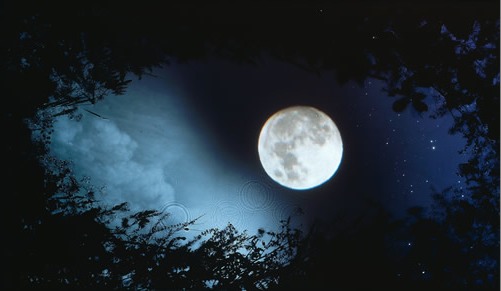
Q: Does having two full Moons in a month make it a Blue Moon?
A: In our modern times, yes, that's what we use that colloquialism to mean. The phrase "Blue Moon" is much older than that, dating back to at least 1528, where a pamphlet attacking the dogmatism of the church states:
Yf they say the mone is belewe
We must believe that it is true.
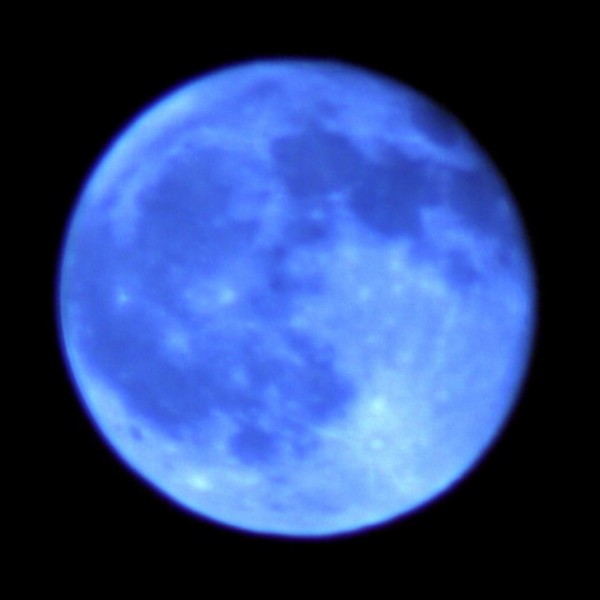
Q: Well, so is it true? Is the Moon belewe blue tonight?
A: No. In fact, if you watch it close to Moonrise or Moonset, you'll see that it gets progressively redder and redder as it gets closer to the horizon, and whiter as it rises higher in the sky. It will never turn blue.
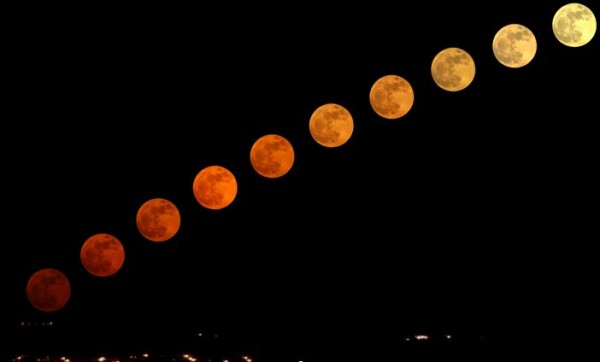
Q: So how did the expression "Blue Moon" come to mean having two full Moons in one month?
A: Each of the 12 Moons in a typical year had a name, some of which still survive to the modern day! For example, harvest moon, hunter's moon, wolf moon, and snow moon are names you may have heard of. (You can see a couple of lists here.) But there aren't 12 full Moons in every year; 12 complete lunar cycles, on average, only take up 354 to 355 days, while a year -- at 365.24 days -- is substantially longer!
So seven times out of every 19 years, there will be 13 full Moons instead of 12. This means that there will be one season in those years that has four full Moons instead of three; the extra one (which they arbitrarily chose to be the third out of four in a season) was called a blue moon.
Q: So why do we call the second full Moon in a month a Blue Moon? Why don't we still use the old definition of the third full Moon in those rare seasons with four?
A: Because of a misinterpretation dating to 1946, which brought the idea of two full Moons in a month being a Blue Moon into popular culture.
This leads to something incredibly interesting: once every 19 years or so, you will have two blue moons in a year! How's this possible? If you have a blue Moon in January -- one full Moon at the very beginning and one full Moon at the end -- the entire (short) month of February can pass by without having a full Moon at all! This way, there will be a full Moon at the very beginning of March, and another one right at the end! This happened in 1999, and will happen again in 2018, so mark your calendars!

Q: Okay, fine, but can the Moon ever actually appear blue, like that Bob Ross painting above?
A: Yes it can! All you need to do is throw particles of the right size up into the atmosphere! You see, the entire spectrum of visible light comes in different wavelengths.
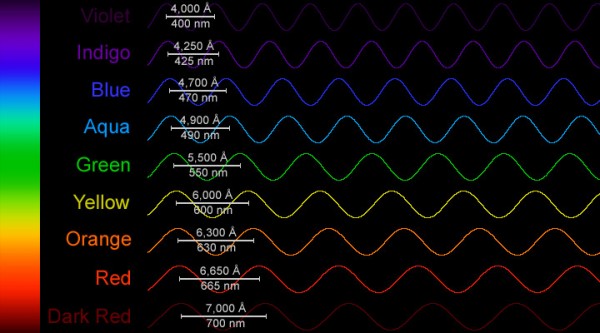
Violet/blue light has the shortest wavelengths, at about 400 nanometers (nm), while red light has the longest, at about 700 nm. Most atmospheric particles are around (or smaller than) the bluest wavelengths in size, which means that blue light gets scattered away (turning the sky blue during the day), and leaving lighted objects appearing red-colored when they're lower down on the horizon.
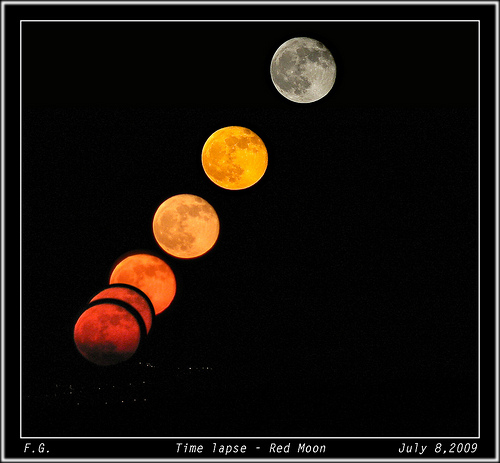
However, certain volcanic eruptions (like Krakatoa or, according to some, Mount St. Helens) will throw up particles with an average size of around 1000 nm, preferentially scattering away the red light (turning the sky red during the day) and leaving lighted objects -- like the Moon -- appearing blue!
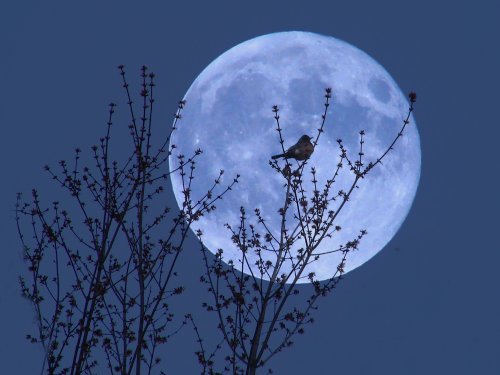
So Moons that are actually blue in color do exist, but that isn't what the expression "blue moon" means! Actual blue-colored moons are even rarer than two full moons in a month. (The latter happens every two-to-three years, which is still pretty rare!)
I can't think of a better way to close out 2009, so enjoy your New Year's Eve celebration! I wish you all a Happy New Year, and I'll see you in 2010!


This post is going to make a 93 year old woman's day! My grandmother and I have been calling each other on the night of the full moons for over five years now. It started because I'd be driving down the interstate and see a full moon and call her to ask her what it's name was. And then the following month, I would find myself in a similar fashion. So now it's a habit. And I just printed this out for her and put it in the mail. It will make her New Year!
Thanks very much for posting this. I found myself wondering yesterday, in conversation, what exactly the phrase "blue moon" meant and where it came from. You've neatly covered that, and answered some other awesome questions. Your post is timely, and appreciated.
When I lived in Appalachia, I saw one blue moon in the dead of winter, and one blood-red moon when there was no snow on the ground. Both were startling, and both were just above the horizon as I left for my dog's evening walk.
nice nice nice
I remember the 1999 double blue moon. My question is, when will the next February blue moon be? And when was the last? It would have to be a leap year, and an especially rare one at that!
BTW, Rodgers & Hart get better press, but for my money, Patrick Alger's song (most prominently covered by Nanci Griffith) is sweeter. I have a version of it posted up today:
http://digitalcuttlefish.blogspot.com/2009/12/once-in-blue-moon-its-new…
Cuttlefish,
Since February has (at most) 29 days, and the lunar period is 29.5 days, the short answer to your question is, "not since before Julius Caesar, and never again." Before Julius stole a day from February for July (and later, Augustus stole another one for August), February had 30 days. That was when the last one was.
If you have a full Moon at 12:00 AM on February 1st, the earliest the next one can be (if your February has 29 days) is about noon on March 1st. So the answer to your question is "never".
Also, tell your mom that I pronounce "aren't" with two syllables as well, although she's on her own with the other two.
Damn. I thought the lunar cycle was just *under*, not just *over* 29 days.
Thanks for the correction!
(and for someone who occasionally relies on meter, a word like "aren't" is a right pain, with a portion of one's readership thinking it is wrong either way.)
I had thought that the blue in the sky was due to Rayleigh scattering with primarily nitrogen gas molecules, not particles.
Have I had it wrong?
healthphysicist,
It is, don't worry, you got it right! The "particles" in this case are the nitrogen, oxygen, and water vapor molecules, which are -- in fact -- significantly smaller than the bluest wavelengths of light.
But they preferentially scatter the light that's closer in size to them: blue instead of red. The same principle is at work here.
But thank you for making me clarify!
Is the moon full everywhere around the world on the same days?
That graph is interesting. Its a perfect superposition of two waves of different frequencies. My guess would be the orbit of the Moon and rotation of the Earth?
The important thing for Rayleigh scattering is that the molecules or particles have a magnetic moment.
Interestingly, when the moon is bright, the night sky is blue. OK, very, very dark blue that looks black, but if you take an overexposed photo, the sky can look quite like day time. I guess this is becuase the moon's scattered light spectrum is not unlike the sun's spectrum.
hi i want to know whether the number of brush that I want to buy
thang you
A http://www.mortgagelasvegasnevada.com/cash-out-refinance.php quick look up at any "blue moon" will pretty much melt even the coldest heart. warm nights guaranteed! giver it a try and see what I mean.
So it's true the moon gets blue!
What's with that color table? The moon can also be red?
That picture with the red moon on 8 iuly 2009 it's my fav
your article reminded me of that song "to the moon and back"
okay i really X3 like the picture of the moon with the beach it is really beautiful thats my favorite one out of all the those pictures on them i dont live on the beach but i hve went there ever sinsce i was a little girl wich was 10 years ago we go there every year our fovorite beach is myrtle beach and it is really pretty and calm there but i most fovirte place i would like to go it hawii its really hot there but i would love to see it there and i would like to a volcano erupt my teacher has walked on lava rocks and i would love to do that with her she is the most beautiful teacher i have ever had in all my school years we are learning about valcanos and how they erupt and we are also learning about earthquakes we had one recently and we dont usaull get one i live in virginia where we really dont get tonaodos and eathqueasts alot but i hope you right bac thanks bye
Love,Carrie Elizabeth Linkous